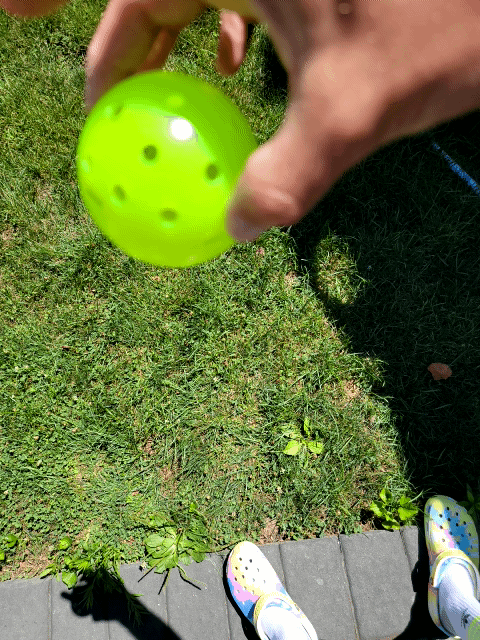Last Updated on November 20, 2025 by Drew Pierce
I recently chatted with a neighbor looking to add a makeshift pickleball court to his property on a limited budget. With minimal asphalt to work with, he asked me, “can you play pickleball on grass?”
My answer was abrupt, “hell no!”
But after taking a beat, I started to wonder…if the grass is short enough and the pickleball ball was swapped out for something with a bit more bounce, could it work?
Maybe.
So I took to the web and almost fell out of my chair when I came across the U.S. Lawn Pickleball Association, folks who apparently want to establish the “Wimbledon of Pickleball.” OK, so their official website is ghosted, and their Facebook page has been dormant since 2018, but maybe this grass thing is growing?
I don’t think the grass is greener when pickleball strays from a hard surface, and here’s why I don’t think you can play pickleball on grass.

Pickleball on Grass = Lack of Speed
Pickleball was born from the ashes of an old badminton court, and those are generally constructed from wood or concrete. The game is designed to be played on a smooth, hard surface so the ball can zip around and players can move quickly. Pickleball is no different.
Inconsistency
A baseball infielder is trained to be ready for inconsistent hops, after all, the game is played on grass and dirt. Since it’s challenging to keep grass at a uniform length, the uneven surface will cause the pickleball to bounce erratically, making it tough to predict where it’s going. Turf is still wonky, but is a better option than grass.

Grass Kills The Kitchen
If the entire game of pickleball was played in the air, the court surface would be a moot point. However, since the ball must bounce in the no-volley zone, you can expect grass to kill any ball momentum and considerably shorten points.
(I Can’t Get No) Spin Satisfaction
Tennis works on grass because the rubber construction and pressurization of the ball lend themselves to bounce–and that’s on both flat shops and spin shots. The rigid plastic design of a pickleball will minimize the amount of spin you can generate once the ball hits the grass.

Playing Pickleball on Grass Is a Slippery Proposition
Can you play pickleball on wet grass? Sure! But you are increasing your odds of getting injured. Slips and falls can lead to catastrophic results, so if you do choose to play on wet grass, please be careful and be sure to wear proper footwear. Also, keep in mind that wet dirt and mud will further deaden the balls’ spin.
Why Would Anyone Want to Play Pickleball on Grass?
Many people looking to play pickleball on grass lack the space for a court or are geographically far from a standard pickleball court. And if you’re a recent pickleball addict, you know that the desire to play is strong. If grass is your only option, go for it!
What are the specific characteristics of a ball that would be more suitable for playing pickleball on grass?
When playing pickleball on grass, the ball’s characteristics need to be tailored to the unique surface conditions. A ball suitable for grass pickleball should have a higher bounce and be slightly heavier than standard indoor pickleball balls. The added weight helps the ball cut through the grass more effectively and maintain a consistent bounce.
Also, the ball’s surface should have a rougher texture or a felt-like material, which provides more friction and grip against the grass blades, preventing excessive skidding or rolling. The ball’s color should be bright and visible against the green grass background, such as a vibrant yellow or orange hue.
Overall, a ball designed for grass pickleball should prioritize a higher bounce, increased weight, a textured surface, and a high-visibility color to compensate for the slower and more inconsistent surface of grass courts.
Are there any modified rules or play styles for grass pickleball?
While the fundamental rules of pickleball remain the same when playing on grass, there are certain modifications and adjustments that players may need to adopt.
First, the serving rules may need to be adapted to account for the slower ball speed and lower bounce on grass. Allowing a higher service toss or a greater number of bounces before returning the serve can help accommodate the surface conditions.
Additionally, players may need to adjust their court positioning and movement strategies, as the grass surface can be more challenging for quick lateral movements and abrupt stops. Adopting a more conservative approach and favoring consistent, controlled shots over aggressive attacking shots can be beneficial on grass courts.
Certain play styles, such as employing more lobs and overhead shots, can be advantageous on grass to compensate for the slower ball speed and lower bounces. Lastly, players may need to adjust their footwork and stances to maintain better balance and traction on the grass surface. While not official rule modifications, these adaptations in play styles and strategies can help players optimize their performance and enjoyment when playing pickleball on grass courts.
In Closing…
As an advocate for the game of pickleball, I’m not saying you can’t enjoy the sport on grass; I’m just suggesting you temper your expectation and go into it for recreational fun. Grass would allow players to be barefoot, perhaps with a cocktail in one hand. Sounds pretty nice, actually.
So yes, dear neighbor, can you play pickleball on grass? Kinda? Grab some field chalk, create court boundaries, use a rubber ball, and give it a try. It might not be “official” pickleball, but who cares. Fun is fun! Let us know how it works out.

1 thought on “Can You Play Pickleball on Grass?”